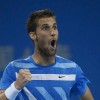By Andrew Eichenholz
In an otherwise ordinary quarterfinal at an ATP World Tour 500 event in Beijing, Martin Klizan played daring, loose tennis to come back and defeat one of the best players of all-time, Rafael Nadal in a three set battle. By the way, the same Klizan was down to his final game, behind 5-1 in the second and what would have been final set of his first round qualifying match at the same tournament against an unknown wild card.
That is why fans need to watch tennis, even after the conclusion of the Grand Slam year with the United States Open in September. Yes, the majors are more often than not the most enthralling sets of two weeks in the season, but what happens after them tend to show who out of the top players are in good form ahead of their offseason and the Australian Open, and who to look out for in the year ahead.
Klizan, for those who do not know him, is no different. A big issue in his career has been falling short in matches that he should win against players ranked far outside the top-100. In fact, although he did have wrist issues, Klizan fell to then-ranked No. 157 Donald Young at the 2013 United States Open while winning a total of two games. Two games in three sets to a guy who was arguably at the bottom of his career cliff is not a very strong performance.
Perhaps there were signs of maturity in holding on against World No. 927 Xin Gao in qualifying of Beijing, a match that may very well propel Klizan to get back into the top-30 in 2015, where he first entered in 2012, and stay there.
For fans who do not remember, it would not be the first time that success on the fall circuit lead to a prosperous following year. Big-hitting Jerzy Janowicz is a prime example.
In 2012, Janowicz made a massive jump, using his results to jump all the way from No. 69 in the world to No. 26 in one week. At the BNP Paribas Masters, the Polish star showed the world a sneak peak of what we have seen ever since. Competitive fire always on display, Janowicz flashed drop shots not to be believed along with a devastating running forehand, shocking opponents as it would whizz by.
Five top-20 players fell at the hands of Janowicz that week, including Andy Murray. Many may have thought it was a one-tournament fluke, but Janowicz would prove them wrong, climbing up to an eventual career high of No. 14, a spot that one could see him getting back to again when the mental aspect of his game is in check.
In 1999, Marat Safin, one of the most dynamic players the game has ever seen would first show his face after the season’s final Grand Slam, reaching the final of the 1999 BNP Paribas Open. Less than a year later, he would claim his throne at the top of the game, reaching the world No. 1 ranking for the very first time the following year.
When all is set and done, people may still choose to focus their tennis time on the main tournaments of the year, the majors. If they want to see what some may call the future stars, watching the fall swing will very likely reap those rewards.
Andrew Eichenholz is a Journalism student at Stony Brook University, where he acts as assistant sports editor of his school newspaper. He writes for both New York Tennis Magazine and Long Island Tennis Magazine, while working as a part-time coach at the USTA Billie Jean King National Tennis Center.


